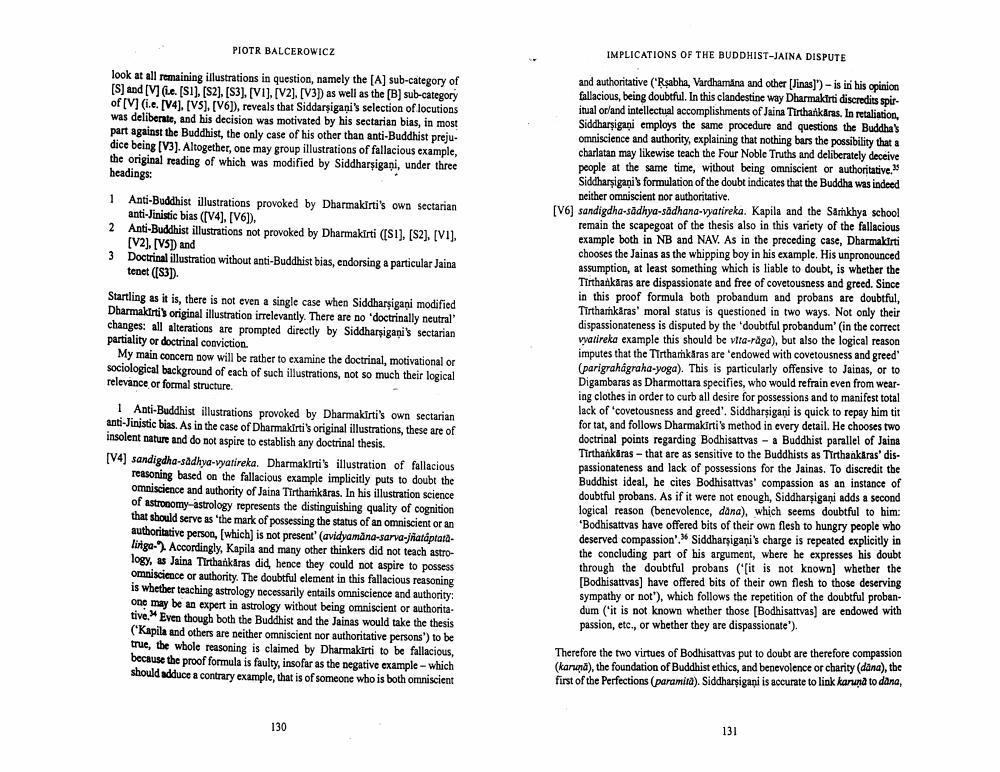________________
PIOTR BALCEROWICZ
IMPLICATIONS OF THE BUDDHIST-JAINA DISPUTE
look at all remaining illustrations in question, namely the (A) sub-category of [S] and [V] (ie. (S1), (S2). [53]. [VI). [V2]. [V3D as well as the (B) sub-category of [V] (i.e. (V4). [VS]. [V6]), reveals that Siddarsigani's selection of locutions was deliberate, and his decision was motivated by his sectarian bias, in most part against the Buddhist, the only case of his other than anti-Buddhist prejudice being (V3). Altogether, one may group illustrations of fallacious example, the original reading of which was modified by Siddharsigani, under three headings:
1
2
Anti-Buddhist illustrations provoked by Dharmakirti's own sectarian anti-Jinistic bias ((V4), (V6]). Anti-Buddhist illustrations not provoked by Dharmakirti (Si), (S2), (VI). (V2), [VSD and Doctrinal illustratioa without anti-Buddhist bias, cadorsing a particular Jaina tenet 83
3
Startling as it is, there is not even a single case when Siddharsigani modified Dharmakirtis original illustration irrelevantly. There are no doctrinally neutral changes: all alterations are prompted directly by Siddharsigani's sectarian partiality or doctrinal conviction
My main concern now will be rather to examine the doctrinal, motivational or sociological background of each of such illustrations, not so much their logical relevance or formal structure.
and authoritative (Rşabha, Vardhamana and other (Jinas)') - is in his opinion fallacious, being doubtful. In this clandestine way Dharmakirti discredits spiritual or/and intellectual accomplishments of Jaina Tirtharkaras. In retaliation, Siddharsigani employs the same procedure and questions the Buddha's omniscience and authority, explaining that nothing bars the possibility that a charlatan may likewise teach the Four Noble Truths and deliberately deceive people at the same time, without being omniscient or authoritative.” Siddharsiganis formulation of the doubt indicates that the Buddha was indeed
Deither omniscient nor authoritative. [V6) sandigdha sådhya-sadhana-watireka. Kapila and the Sarkhya school
remain the scapegoat of the thesis also in this variety of the fallacious example both in NB and NAV. As in the preceding case, Dharmakirti chooses the Jainas as the whipping boy in his example. His unpronounced assumption, at least something which is liable to doubt, is whether the Tirtharkaras are dispassionate and free of covetousness and greed. Since in this proof formula both probandum and probans are doubtful, Tirtharkiras' moral status is questioned in two ways. Not only their dispassionateness is disputed by the doubtful probandum' (in the correct vyatireka example this should be vita-raga), but also the logical reason imputes that the Tirthakaras are 'endowed with covetousness and greed (parigrahágraha-yoga). This is particularly offensive to Jainas, or to Digambaras as Dharmottara specifies, who would refrain even from wearing clothes in order to curb all desire for possessions and to manifest total lack of covetousness and greed'. Siddharsigani is quick to repay him tit for tat, and follows Dharmakirti's method in every detail. He chooses two doctrinal points regarding Bodhisattvas - a Buddhist parallel of Jaina Tirthankáras - that are as sensitive to the Buddhists as Tirthankaras' dispassionateness and lack of possessions for the Jainas. To discredit the Buddhist ideal, he cites Bodhisattvas' compassion as an instance of doubtful probans. As if it were not enough, Siddharsigani adds a second logical reason (benevolence, dana), which seems doubtful to him. "Bodhisattvas have offered bits of their own flesh to hungry people who deserved compassion'. Siddharsigami's charge is repeated explicitly in the concluding part of his argument, where he expresses his doubt through the doubtful probans ('[it is not known whether the [Bodhisattvas) have offered bits of their own flesh to those deserving sympathy or not), which follows the repetition of the doubtful probandum (it is not known whether those [Bodhisattvas) are endowed with passion, etc., or whether they are dispassionate').
1 Anti-Buddhist illustrations provoked by Dharmakirti's own sectarian anti-Jinistic bias. As in the case of Dharmakirtis original illustrations, these are of insolent nature and do not aspire to establish any doctrinal thesis. [V4) sandigdha-sadhya-vyatireka. Dharmakirtis illustration of fallacious
reasoning based on the fallacious example implicitly puts to doubt the omniscience and authority of Jaina Tirtharkaras. In his illustration science of astropomy-astrology represents the distinguishing quality of cognition that should serve as the mark of possessing the status of an omniscient or an authoritative person, (which) is not present' (avidyamana-sarva-fiataptatliriga-9. Accordingly, Kapila and many other thinkers did not teach astro logy, as Jaina Tirthankiras did, hence they could not aspire to possess omniscience or authority. The doubtful element in this fallacious reasoning is whether teaching astrology necessarily entails omniscies one may be an expert in astrology without being omniscient or authorita tive. Even though both the Buddhist and the Jainas would take the thesis ("Kapila and others are neither omniscient nor authoritative persons') to be true, the whole reasoning is claimed by Dharmakirti to be fallacious, because the proof formula is faulty, insofar as the negative example - which should adduce a contrary example, that is of someone who is both omniscient
Therefore the two virtues of Bodhisattvas put to doubt are therefore compassion (kanan), the foundation of Buddhist ethics, and benevolence or charity (dana), the first of the Perfections (paramita). Siddharşigani is accurate to link karun to dana,
130




